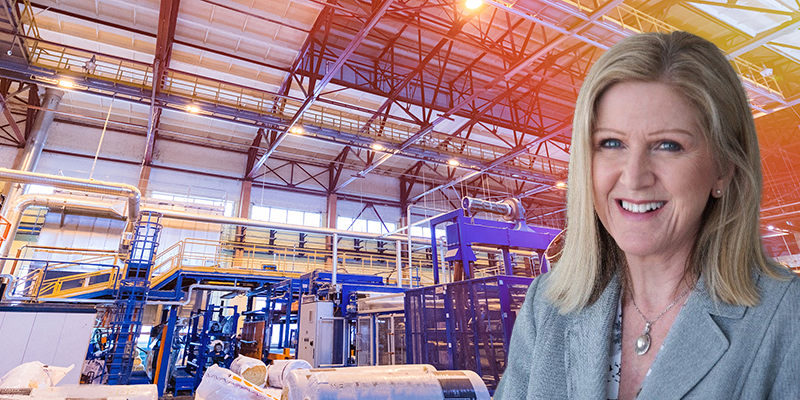By a show of hands, I.CON West keynote speaker Christine Cooper, Ph.D., managing director and chief U.S. economist with CoStar Group, polled attendees on their economic outlook – was it bright or bleak? The group responded largely positively, with most indicating they felt the economy was doing better than not.
Four years ago, the World Health Organization declared COVID-19 a global pandemic, seemingly halting life as we knew it. And although those early days of the pandemic seem like a long time ago, we’re still in recovery from two of its major consequences: 1) the $4 trillion in economic stimulus that the U.S. government showered on consumers; and 2) the aggressive monetary policies that have created ripple effects on the industrial markets.
Cooper began with an overview of the economic environment, which she called “the good news.” The nation’s GDP is strong, and the economy gained momentum in the second half of 2023 – we saw economic growth of 4.9% and 3.2% in Q3 and Q4 respectively — much higher than expected. “The reason is consumers,” Cooper said. “When things get tough, we go shopping. This generates sales and economic activity. But how long can it last?”
Consumer sentiment continues to be healthy, and employment is good, although a shortage of workers could impact that moving forward. The U.S. added 275,000 jobs in January, far exceeding expectations. “The Fed raising interest rates hasn’t done what it normally does – slow job growth and the economy,” said Cooper. In addition, the $4 trillion given to keep households afloat during the pandemic has simply padded checking accounts, she said, as consumers couldn’t immediately spend the money because everyone was staying home, and the supply chain was clogged. The money was banked, and there’s still a lot of it to be spent.
Cooper addressed economic risks and the weak points that industrial real estate professionals should be mindful of right now, including mortgage rates that remain at 20-year highs, stalling the housing market, particularly for new home buyers. Mid-pandemic years of 2020-2021 had strong home sales, driven by people moving out of the city or roommates dividing into two properties for more space and protection against the virus. Homeowners who refinanced in the early stages of the pandemic were fortunate and aren’t willing to list their houses for sale quite yet.
“The housing market is a big driver of industrial demand – think furniture, appliances and all the durable goods that go into a home. This equates to warehouse space demand,” said Cooper.
Interest rates on consumer credit are spiking and leading economic indexes are still signaling a recession ahead. Financial markets are indicating the same, with a current probability of 61.5% that we will be in a recession by 2025. However, Cooper said, while all signs point to a recession, economists everywhere say the same thing as the economy seemingly continues to surprise us: “This time is different.”
Consumers are still holding the economy up with solid job and wage gains, yet higher borrowing costs are weighing on business activity and the housing market. Inflation has eased meaningfully but remains a bit too high for comfort. We’ve so far avoided the recession that everyone predicted, and the Federal Reserve appears ready to cut rates this year.
For the industrial markets, the good news is that retailer corporate profits are beginning to bounce back after slowing in 2021 and 2022, with retail sales accelerating.
A slowdown in industrial space absorption was reflected in all the key markets – Atlanta, Chicago, Columbus, Dallas-Fort Worth, Houston, the Inland Empire, Los Angeles, New Jersey and Phoenix – but was worst in the southern California markets, which have since been rebounding.
“Supply responded to strong demand,” Cooper said. “In 2021, 307 million square feet were delivered, followed by 395 million in 2022. In 2023, we saw 534 million square feet delivered – that’s almost 33% higher than the year before.”
The top 20 markets for 2023 deliveries measured by square feet are the expected hot spots: Dallas-Fort Worth (71 million square feet) leads the pack by almost double its follower of Chicago (37 million), then Houston (35 million), Phoenix (30 million) and Atlanta (29 million). Measured by share of inventory, emerging markets like Spartansburg, Pennsylvania, topped the list at 15 million square feet, followed by Austin (10 million), Phoenix and Dallas-Fort Worth (7 million), and Columbus (6 million).
“Developers are more focused on big box distribution projects, and 90% of what’s being delivered is 100,000 square feet or more,” Cooper said. Around 400 million square feet of space currently under construction is unleased, in addition to the around 400,000 square feet that remained unleased in 2023. “Putting supply and demand together, industrial vacancy rate is rising and could peak at 6-7% in 2024,” she said.
In conclusion, Cooper said that industrial real estate is rebalancing from its boom-and-bust years. Pandemic-related demands and accelerated e-commerce growth created a surge in 2021 and 2022, and the strong supply response that began in 2022 will continue to unfold through 2024. With rising interest rates putting a damper on demand in 2023, vacancies began to move higher and will continue to rise this year.
“Consumers are spending and will continue to do so, and interest rates are likely to fall this year,” said Cooper. “We can hope for a recovery from the full effects of the pandemic in 2025.”

This post is brought to you by JLL, the social media and conference blog sponsor of NAIOP’s I.CON West 2024. Learn more about JLL at www.us.jll.com or www.jll.ca.














